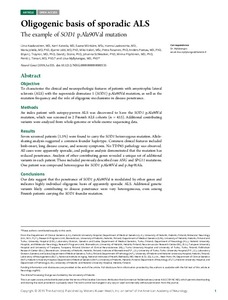Oligogenic basis of sporadic ALS The example of SOD1 p.Ala90Val mutation
Liina Kuuluvainen; Karri Kaivola; Saana Mönkäre; Hannu Laaksovirta; Manu Jokela; Bjarne Udd; Miko Valori; Petra Pasanen; Anders Paetau; Bryan J. Traynor; David J. Stone; Johanna Schleutker; Minna Pöyhönen; Pentti J. Tienari; Liisa Myllykangas
Oligogenic basis of sporadic ALS The example of SOD1 p.Ala90Val mutation
Liina Kuuluvainen
Karri Kaivola
Saana Mönkäre
Hannu Laaksovirta
Manu Jokela
Bjarne Udd
Miko Valori
Petra Pasanen
Anders Paetau
Bryan J. Traynor
David J. Stone
Johanna Schleutker
Minna Pöyhönen
Pentti J. Tienari
Liisa Myllykangas
LIPPINCOTT WILLIAMS & WILKINS
Julkaisun pysyvä osoite on:
https://urn.fi/URN:NBN:fi-fe2021042824114
https://urn.fi/URN:NBN:fi-fe2021042824114
Tiivistelmä
Objective To characterize the clinical and neuropathologic features of patients with amyotrophic lateral sclerosis (ALS) with the superoxide dismutase 1 (SOD1) p.Ala90Val mutation, as well as the mutation frequency and the role of oligogenic mechanisms in disease penetrance. Methods An index patient with autopsy-proven ALS was discovered to have the SOD1 p.Ala90Val mutation, which was screened in 2 Finnish ALS cohorts (n = 453). Additional contributing variants were analyzed from whole-genome or whole-exome sequencing data. Results Seven screened patients (1.5%) were found to carry the SOD1 heterozygous mutation. Allele-sharing analysis suggested a common founder haplotype. Common clinical features included limb-onset, long disease course, and sensory symptoms. No TDP43 pathology was observed. All cases were apparently sporadic, and pedigree analysis demonstrated that the mutation has reduced penetrance. Analysis of other contributing genes revealed a unique set of additional variants in each patient. These included previously described rare ANG and SPG11 mutations. One patient was compound heterozygous for SOD1 p.Ala90Val and p.Asp91Ala. Conclusions Our data suggest that the penetrance of SOD1 p.Ala90Val is modulated by other genes and indicates highly individual oligogenic basis of apparently sporadic ALS. Additional genetic variants likely contributing to disease penetrance were very heterogeneous, even among Finnish patients carrying the SOD1 founder mutation.
Kokoelmat
- Rinnakkaistallenteet [27094]
